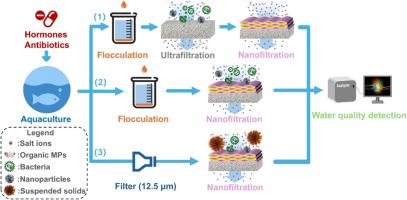Micropollutants removal from aquaculture water using layer-by-layer self-assembled nanofiltration membranes
IF 11.4
1区 环境科学与生态学
Q1 ENGINEERING, ENVIRONMENTAL
引用次数: 0
Abstract
Micropollutants (MPs) in aquaculture water are directly related to human health, but largely overlooked. The conventional water treatment technologies could not effectively remove MPs, and new technologies have been pursued with high MP removal rate, low cost and small footprint. This paper reported the first endeavor of using layer-by-layer (LBL) hollow fiber (HF) nanofiltration (NF) membranes to treat real aquaculture water. We compared three types of membranes with various surface chemical properties and pore sizes assembled by different polyelectrolytes (PEs). The MPs removal rates and operation stability of three NF membranes were studied in flocculation (Floc.)/ultrafiltration (UF)/NF, Floc./NF and direct NF processes. The best poly(styrene sulfonate)/poly(allylamine hydrochloride) (PSS/PAH) NF membrane showed almost 100 % MPs removal in Floc./UF/NF, and above 95 % in direct NF process. Stable permeance was observed in three 24 h cycles for three processes. The correlation hot spot analysis between the physical properties and removal rates of MPs confirmed importance of size exclusion as the important factor for removal of MPs. The organic humus, rather than inorganic silicon and calcium, was found as the main foulant, which increased slightly the pore size of the LBL membranes with small pores, but blocked pores of membranes with large pores, affected the rejection for ions as well. The cost assessment based on (PSS/PAH)2.5 showed a total cost below 0.75 ¥/ton water, which is feasible to efficiently remove MPs from aquaculture water by NF membrane process.


利用逐层自组装纳滤膜去除水产养殖水中的微污染物
水产养殖水体中的微污染物与人类健康直接相关,但在很大程度上被忽视。传统的水处理技术不能有效去除水中的多聚氰胺,高去除率、低成本、小足迹的新技术得到了广泛的应用。本文报道了采用逐层(LBL)中空纤维(HF)纳滤(NF)膜处理真实养殖水体的首次尝试。我们比较了三种由不同聚电解质(PEs)组装而成的具有不同表面化学性质和孔径的膜。研究了絮凝(絮凝)/超滤(超滤)/纳滤(絮凝)、絮凝(絮凝)、絮凝(絮凝)三种滤膜对MPs的去除率和运行稳定性。/NF和直接NF进程。最佳的聚苯乙烯磺酸盐/聚丙烯胺盐化物(PSS/PAH)纳滤膜对絮凝体的MPs去除率接近100%。/UF/NF,在直接NF工艺中达到95%以上。三种工艺在三个24 h循环中观察到稳定的渗透。物理性质与MPs去除率之间的相关热点分析证实了粒径排除是MPs去除率的重要因素。有机腐殖质是主要的污染物,而无机硅和钙是主要的污染物。有机腐殖质对小孔LBL膜的孔径略有增大,但对大孔LBL膜的气孔有阻塞作用,对离子的截留也有影响。基于(PSS/PAH)2.5的成本评价表明,总成本低于0.75元/吨水,采用纳滤膜法有效去除水产养殖水体中MPs是可行的。
本文章由计算机程序翻译,如有差异,请以英文原文为准。
求助全文
约1分钟内获得全文
求助全文
来源期刊

Water Research
环境科学-工程:环境
CiteScore
20.80
自引率
9.40%
发文量
1307
审稿时长
38 days
期刊介绍:
Water Research, along with its open access companion journal Water Research X, serves as a platform for publishing original research papers covering various aspects of the science and technology related to the anthropogenic water cycle, water quality, and its management worldwide. The audience targeted by the journal comprises biologists, chemical engineers, chemists, civil engineers, environmental engineers, limnologists, and microbiologists. The scope of the journal include:
•Treatment processes for water and wastewaters (municipal, agricultural, industrial, and on-site treatment), including resource recovery and residuals management;
•Urban hydrology including sewer systems, stormwater management, and green infrastructure;
•Drinking water treatment and distribution;
•Potable and non-potable water reuse;
•Sanitation, public health, and risk assessment;
•Anaerobic digestion, solid and hazardous waste management, including source characterization and the effects and control of leachates and gaseous emissions;
•Contaminants (chemical, microbial, anthropogenic particles such as nanoparticles or microplastics) and related water quality sensing, monitoring, fate, and assessment;
•Anthropogenic impacts on inland, tidal, coastal and urban waters, focusing on surface and ground waters, and point and non-point sources of pollution;
•Environmental restoration, linked to surface water, groundwater and groundwater remediation;
•Analysis of the interfaces between sediments and water, and between water and atmosphere, focusing specifically on anthropogenic impacts;
•Mathematical modelling, systems analysis, machine learning, and beneficial use of big data related to the anthropogenic water cycle;
•Socio-economic, policy, and regulations studies.
 求助内容:
求助内容: 应助结果提醒方式:
应助结果提醒方式:


